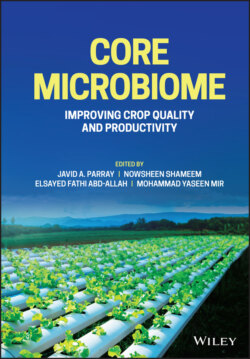Читать книгу Core Microbiome - Группа авторов - Страница 16
2.2 Plant–Microbe Interaction in the Rhizosphere
Оглавление“Rhizosphere” is derived from “rhiza” or root and “sphere” or the field of influence in ancient Greek. The rhizosphere is the soil environment surrounding plant roots, and it is a crucial underground region for plant–microbe interaction. The rhizosphere comprises 10-fold microbes more than that in the surrounding soil, and the rhizosphere microbiome may consist of fungi, bacteria, archaea, actinomycetes, and viruses [3]. Roots utilize photosynthates to produce exudates used by rhizosphere microbiota to exchange nutrients and water [4]. Root exudates also function as signaling molecules, attractants, stimulants, or repellents to rhizosphere microbes. Bioactive compounds of exudates vary with plant species that define microbial community [5]. Root secretion influences soil pH, soil structure, oxygen obtainability, and influences plant–microbe interaction. A study on secondary metabolite benzoxazinoids showed it’s defensive role in cereals, alters rhizosphere fungal and bacterial microbiota, and influences plant growth [6]. Bacteria produce protein and polysaccharides, which allow them to attach with roots as biofilm aggregates [7]. Symbiotic association evolved millions of years ago, and most living plants form a symbiotic relationship with arbuscular mycorrhizal fungi (AMF) [8]. Upon sensation of strigolactone from plant roots, AMF initiates hyphal branching to colonize roots and releases lipochito oligosaccharides, promoting plant growth by increasing root surface area [1]. Almost all soilborne fungi are necrotrophic, and they do not require the living cell to acquire nutrients.
